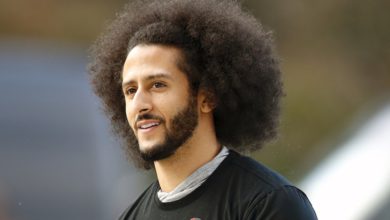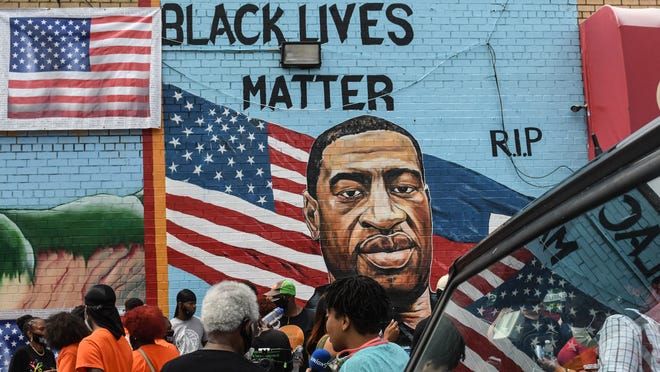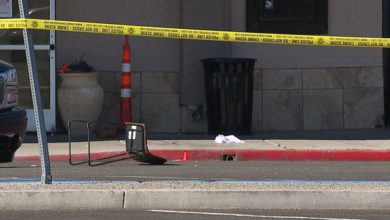

Parents packed a school board meeting near Cleveland. They flooded the Ohio State Board of Education with comments. They launched early campaigns for board seats in a Cincinnati suburb. And they lobbied state lawmakers into writing not one but two separate bills to ban the teaching of "critical race theory."
"It didn’t seem right to me. It didn’t seem like something kids should be taught," said Ben James, a Columbus parent. "To tell someone that you need to feel bad for being the shade that you are, that’s wrong, man. That is so wrong."
It's not in his son's school yet, but districts from Cleveland to Cincinnati adopted "anti-racist" policies in the wake of George Floyd's murder to promote diversity, equity and inclusion.
James, who is Black, believes these "buzzwords" are code for critical race theory, which he says is a divisive and harmful narrative that has no place in Ohio schools.
"This is trying to get at kids at an early age to divide at an early age," James said. "If we teach this to elementary school kids now, by the time they get to high school we’re going to be back to segregation."
Supporters are split on whether what they're teaching fits under the umbrella of critical race theory, or CRT. Legal scholars who study the theory are pretty certain it doesn't.
To them, CRT's transformation into a conservative battle cry is either a misunderstanding or a blatant attempt to misuse all diversity efforts to further fears about indoctrination and dismantle public schools.
What is critical race theory?
Critical race theory is an academic field of study like philosophy, sociology or economics, said Ohio University professor Vince Jungkunz.
"It has not resided in a pronounced way in (K-12) schools before Republican lawmakers started talking about it," Jungkunz said.
Jungkunz, who has taught a class on CRT since 2004, described it as a way of understanding how racism shaped life in America, using examples from his personal life. Jungkunz, who is white, met his former wife, who is Black, in the late 1980s.
"We started to notice almost like this sociological difference," Jungkunz said. "I would be treated completely differently than she would be treated."
Hotel clerks would tell her they had no rooms were available, but he would be offered a key. Sometimes there would be a vacancy, but her rate would be higher than his.
"Hotels, rental car rates, teacher evaluations that mentioned the texture of her hair. That's how I knew white privilege was real," he said.
The civil rights movement purged "blatant racism" from the law, he said, but it didn't purge the beliefs that created "separate but equal" systems. That’s the focus of critical race theory.
For example, a few years ago major technology companies marketed their facial recognition software to police departments across the globe until researchers from Stanford and MIT found the error rates for people of color generally – and Black women in particular – alarmingly higher than their white male counterparts.
A test of Amazon's "Rekognition" software misidentified 28 members of Congress as criminals, including the late civil rights legend U.S. Rep. John Lewis.
Critical race theory, Jungkunz said, would ask the coders to go beyond fixing the software and discover why their programs had these biases to begin with.
Masking racism as diversity
That all sounds good, said Aaron Baer, the director of the Center for Christian Virtue. But that's not what's being pushed in schools.
"Everyone I know who is objecting to CRT, we would all be on board with having more diverse viewpoints," Baer said. "Let’s not be afraid to engage with those ideas, but there’s a massive leap between CRT and respecting and celebrating diversity."
He sees a borderline racist ideology that teaches children "there is a certain group of people who are irredeemably evil and awful based on the color of their skin."
And Rep. Don Jones, R-Freeport, sees a worldview in CRT that goes against the American dream and claims meritocracy was created to oppress people of color.
"It’s really based off of Marxism, and the fact that we should make those who have been successful feel that they have been privileged," Jones said. "I think that’s an important thing to realize. We are looking for equality in opportunity, not equality in outcome."
Controversy over the 1619 Project
What brought critical race theory out of academic obscurity was a collection of essays, poems and commentaries compiled by the New York Times in a Pulitzer Prize-winning initiative called the 1619 Project.
Named for the year Africans first landed on American soil, the project attempted to reframe U.S. history with a focus on slavery and the contributions of Black Americans.
Former President Donald Trump called the project “toxic propaganda” and “ideological poison that if not removed will dissolve the civic bonds that tie us together.”
He disparaged school districts that began incorporating the project into their history lessons, and he convened his own “1776 Commission” to write a “patriotic” curriculum for schools to use. President Joe Biden dismantled the commission on his first day in office.
In April, the U.S. Department of Education published a proposal for federal grants for schools that incorporate diverse perspectives into their history lessons and used the 1619 Project as an example.
By June, lawmakers in 16 states had introduced or passed bills to ban its teaching.
What’s happening in Ohio
In July 2020, Ohio's State Board of Education adopted a resolution condemning racism. The three-page document acknowledged the achievement gap between white students and kids of color and promised Ohio would do better.
The resolution called on the Department of Education to offer training on implicit bias and "strongly recommend(ed) that all Ohio school districts begin a reflection and internal examination of their own."
Some districts, such as Cincinnati Public Schools, took the idea to heart. Its board approved an anti-racism policy in December, which included a commitment to developing new, anti-racist lesson plans for students at every grade level.
Board member Mike Moroski said they haven't experienced any community pushback, and he doesn't expect to see a bunch of angry parents once the new curriculum becomes official.
Some teachers are already weaving diversity lessons into their teachings.
“Yes, it probably gets very close to what you would consider critical race theory,” said Trent White, a social studies teacher at Cincinnati's Aiken High School. “Being very critical of the idea that a lot of the legal foundations of this country were founded to help white people prosper and either did not think about African Americans or some were intentionally done to (Black people)."
About 69% of Ohio's public school kids are white, according to the most recent data from the state. Akien High School, however, is 95% minority with the majority of students – 78% – being Black.
White said he tailored his teaching to his students, many of whom view U.S. history through the lens of the Black experience.
That doesn't mean he teaches kids that all white people throughout history were racist. His goal is not to teach students to hate America. But he doesn't give kids a "rosy, autobiographical version" of the nation's history, either.
He also incorporates local issues like redlining, which was a way banks marked predominately Black neighborhoods on maps in order to deny them loans and other financial services.
White wants his students "to understand that you can be critical of America without hating America."
Local control or local protection?
In Hudson City School District, where 85% of the students are white, parents lined up in opposition to the way its schools were teaching about diversity.
The school board said in a statement that it wasn't teaching critical race theory or the 1619 Project. But parents told News 5 Cleveland they viewed lessons about white privilege as indoctrination.
This is why we have local control, Rep. Erica Crawley, D-Columbus, said. “School districts should be able to allow teachers to teach whatever they believe is necessary for that subject.”
Ohio has more than 600 school districts. What works in one might not work in another, she said. But House Bill 322 would cut into that academic freedom.
It wouldn't explicitly ban the 1619 Project, but it would ban any lesson claiming "the advent of slavery in the territory that is now the United States constituted the true founding of the United States."
And it would prohibit teaching slavery and racism as "anything other than deviations from true American values like 'liberty and equality.'"
A district could lose its funding if it taught in a way that made a student "feel discomfort, guilt, anguish, or any other form of psychological distress on account of the individual's race or sex."
House Bill 327, sponsored by Republican Reps. Diane Grendell and Sarah Fowler Arthur, goes a step further. It includes prohibitions for higher education and mandatory training for state employees on what the bill calls "divisive concepts."
"When you are teaching something divisive, it's important to make sure that it is as well-rounded as possible," Fowler Arthur said.
Her bill doesn't ban the teaching of controversial issues. It simply requires them to be taught in an "an objective manner" that presents "a complete view of history." CRT, in her opinion, "teaches a narrative view of history."
Ohio lawmakers need to intervene here, Fowler Arthur said, to protect teachers and other state employees from being forced into accepting these ideas just to keep their jobs.
Both bills also attempt to ban federal intrusion on this topic. The federal government could "coerce" districts into choosing critical race theory curricula with federal funds, Fowler Arthur said, like they did with the Common Core standards.
“They incentivized it through a grant process directly to local school districts,” she said. “A majority of districts didn’t want to voluntarily participate, but everyone was eventually forced to comply.”
Source link








